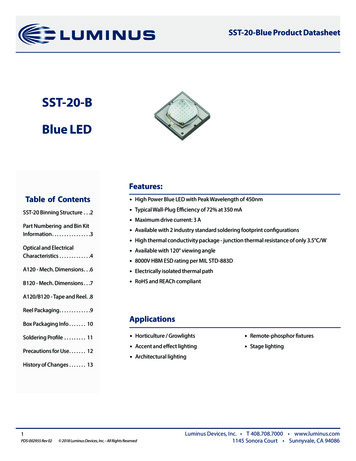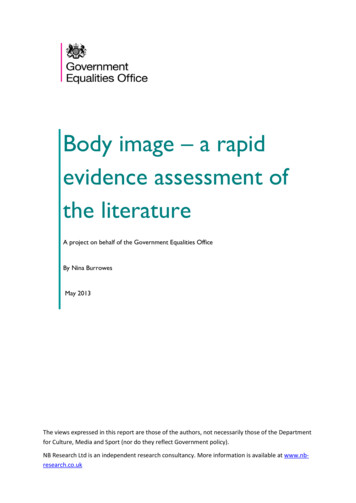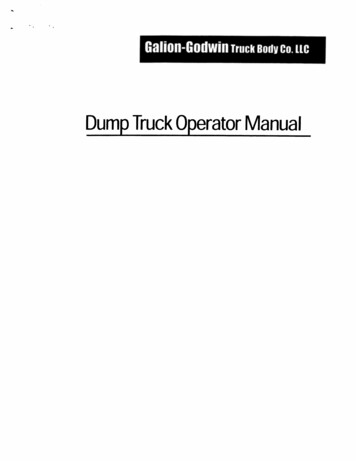
Transcription
tra nspa re nt b ody,lumi nou s wor ld
i ntroduc tio nAs a young adult my interest in truth or the nature of reality involved thestudy and practice of the non-dual tradition of Advaita Vedanta. I receivedthe initial teaching in this tradition at Colet House in London from Shantananda Saraswati, at that time the Shankaracharya of the north of India,and through the writings of Ramana Maharshi, who was my constantcompanion during those years. is exploration reached its culminationwhen, in my mid-thirties, I met my teacher, Francis Lucille, who introduced me to the teachings of Atmananda Krishna Menon and, more importantly, directly indicated the ultimate reality of experience.Until this encounter, my primary interest had been the recognition of mytrue nature, which I considered to be the height of the spiritual path.However, soon after we met, Francis also introduced me to the Tantricapproach of Kashmir Shaivism, which he had learnt from his teacher,Jean Klein, who himself had brought it from India to the West towardsthe end of the twentieth century. As a result, I realised that the recognitionof our true nature is a stage in but not the end of the spiritual path. eaim of this approach is to establish the non-dual understanding in allrealms of experience. It involves a process of realigning the way we feelthe body and perceive the world with the recognition of our true natureof eternal, infinite Awareness.Many traditional and contemporary commentaries place the Tantric tradition in opposition to the Vedantic approach. As a student I was sparedthis conflict, for the two approaches were presented as inner and outerfaces of the same complete teaching. It is in this spirit that TransparentBody, Luminous World presents the Tantric teaching in this collection.Although the purpose of this collection is to present a contemporary
in t ro d u ct i o nrendition of the Tantric approach to sensation and perception, I wouldlike to place this approach in the context of the Vedantic path.*** e essence of the Vedantic path involves an inversion of attention uponits source, which can be triggered by a question such as, ‘Who am I?’,‘What is it that is aware of my experience?’, ‘Am I aware?’, ‘From wheredo my thoughts come?’, ‘What element of experience cannot be removedfrom me?’ or ‘What is the essential, irreducible nature of the mind?’ Suchquestions have the power to invite the mind away from its customary objects of interest – thoughts, images, feelings, sensations and perceptions– towards its source, the subjective experience of being aware, or Awareness itself. is enquiry culminates in Awareness’s recognition of its owneternal, infinite nature. is path is sometimes referred to as self-enquiry or self-investigation.However, these terms – translations of the Sanskrit term atma vichara –are potentially misleading. ey imply an activity of the mind rather than,as Ramana Maharshi described it, a sinking or relaxing of the mind into‘the heart’, that is, into its source of pure Awareness or Consciousness. e term may, therefore, be more accurately translated as ‘self-abiding’or ‘self-resting’, and is the essence of what is known in various spiritualand religious traditions as prayer, meditation, self-remembering, Hesychasm in the Greek Orthodox Church, or the practice of the presence ofGod in the mystical Christian tradition.In order to undertake this ‘inward-facing’ path, one first has to separateoneself from everything that is not inherent in one’s essential being, whichshines in each of our minds as the knowledge ‘I’ or ‘I am’. To establishthe presence and primacy of our essential identity of pure Awareness, wehave to separate ourself from those aspects of experience that are not inherent in us: our thoughts, feelings, sensations and perceptions. In doingso, we arrive at the conclusion, ‘I am nothing that can be thought, felt,sensed or perceived; that is, I am nothing, not a thing or any kind of objective experience. I am the ever-present witness of experience, but amnot myself an object of experience.’In the Vedantic tradition this path of separating oneself from everythingthat is superfluous to one’s essential being of pure Awareness is oftenxiv
in t ro d u c t i o ninitiated by a process referred to as neti neti – ‘I am not this, not this’ –and leads to the recognition ‘I am Awareness or Consciousness itself ’. is recognition is not itself enlightenment (although it is often mistakenas such in contemporary expressions of the non-dual teaching), but itpaves the way for it. A deeper exploration of the nature of Awareness isrequired, culminating in Awareness’s recognition of its own eternal, infinite nature. In this recognition, no new knowledge is gained or experienced. Rather, previous beliefs are removed from Awareness, enabling itsessential, indivisible, irreducible nature to stand revealed. e beliefs that make Awareness appear to be temporary and finite, thatis, that make Awareness appear to share the destiny and limits of the body,are referred to in the Vedantic tradition as ‘ignorance’. Ignorance is notan object that obscures the nature of Awareness, but rather an activity ofthinking and feeling. e cessation of this obscuring activity is the processthrough which Awareness ceases to hide itself from itself in the form ofmind, and recognises itself as it is. e neti neti process is, therefore, aprelude to the deeper exploration of self-enquiry or self-investigation,leading to self-abidance or self-resting. In this self-abidance, Awarenessis, in most cases gradually but occasionally suddenly, divested of its limitations and, at some point, stands revealed to itself as it essentially is.***Awareness’s recognition of its own eternal, infinite nature is variouslyknown in the spiritual traditions as enlightenment, awakening, illumination or the simple recognition of one’s essential, self-aware being – itsrecognition of itself. It is the culmination of the Inward Path, the Path ofExclusion, the Path of Return, the Path of Discrimination, the Path ofKnowledge, Jnana Yoga or, as it is known in the Zen tradition, the GreatDeath. is approach is sometimes referred to collectively as the DirectPath, in that the mind turns its knowing or attention directly towards itssource, irrespective of the content or condition of objective experience.No preparation, manipulation or purification of the mind or body is required as a prerequisite to this approach. In fact, from the point of viewof the Direct Path, the progressive approaches are considered preparationsfor this final stage of the inward-facing path.All the highest spiritual teachings express the same essential understanding, because the nature of reality is not something that varies from culturexv
in t ro d u ct i o nto culture. However, the form of its expression arises out of the culturein which it is expressed. A teaching is conditioned, though not essentiallychanged, by the local and temporal traditions of that culture. e DirectPath is, in my opinion and experience, the one that is best suited to ourage and culture, and it is made most explicit in the Vedantic path of selfinvestigation and self-abidance.However, this turning away from the objective elements of experience –thoughts, feelings, sensations and perceptions – for the purpose of establishing the presence, primacy and nature of Awareness still leaves a distinction between Awareness and its objects. In some traditionalexpressions of the teaching, this distinction may inculcate a negative attitude towards objective experience, considering it a hindrance to Awareness’s recognition of its own being. It is in this context that we findexpressions such as ‘the despicable body’ or ‘the filthy ego’ in some traditional and even some contemporary non-dual texts. For the full integration of this new understanding into all realms of our lives, the relationshipbetween Awareness and its objects must be fully explored, and eventuallydissolved.Even after the recognition of our essential nature of eternal, infiniteAwareness, it is common for many of us to find a discrepancy betweenwhat we understand and what we feel. We may understand that everything appears in Awareness, is known by Awareness and is made of Awareness, and yet we may still feel the body as something solid, dense, limitedand located. Likewise, and as an inevitable corollary to this feeling, wemay perceive the world as something that is separate and at a distancefrom ourself. us, our thoughts may be more or less free of the separateself, but our feelings and perceptions, and subsequent activities and relationships, may betray the residues of an apparently separate self still present in the deeper, more hidden layers of experience. e yoga meditationspresented in this collection are aimed at dissolving this discrepancy. is approach, which I call the Tantric Yoga of Sensation and Perception,starts with the recognition of our true nature and proceeds from there tofully explore the relationship between Awareness and objective experience.Although this relationship is implicit in the Vedantic tradition, it wasmade explicit in the Tantric traditions, particularly that of KashmirShaivism. Ramana Maharshi would sit for many hours in silence with hisstudents, and the exposure and dissolution of these feelings would bebrought about in this silence. In the Tantric traditions, of which this Yogaxvi
in t ro d u c t i o nof Sensation and Perception is a contemporary expression, a more proactive approach is taken to exploring the feeling of separation in the body.Thus, the two traditions of Vedanta and Kashmir Shaivism are complementary aspects of a complete approach to the exploration of experience, and not, as we so often find in scholastic commentaries on thesetwo traditions, at odds with each other. Unfortunately, many contemporary Western expressions of the Tantric tradition are not sufficientlyadapted to the culture in which they now find themselves and, as a result, the form of these teachings is often adhered to at the expense oftheir meaning.In the cultures in which these teachings originated, their forms were tailored to the requirements of the people at hand, evolving and changingspontaneously, and always developing new pathways that correspondedintimately with their questions, difficulties and resistances. As such, thetrue Tantric tradition was a living, growing flame that was passed on fromgeneration to generation, not a series of codified practices that could bedisseminated by teachers and mechanically applied by students. In ourculture, in the absence of this living tradition, a surrogate tradition ofdogmas, codes and practices, still redolent of its countries of origin, masksthe true teaching with elements that are foreign to the culture in whichit now finds itself. is shrouds the teaching in an air of mystery, obscurityand esotericism, which the seeking ego mistakes for profundity and authenticity, and in which it takes refuge.*** e Tantric path, of which the meditations presented in this collectionare a contemporary expression, involves a turning towards experience.It is an exploration of objective experience in the light of our enlightenedunderstanding, rather than a turning away from experience in favour ofits background of pure Awareness, as is the case in the Vedantic approach.If the Vedantic path is the path from ‘I am something’ – a body and mind– to ‘I am nothing’, the Tantric path could be said to be the path from ‘Iam nothing’ to ‘I am everything’. If the Vedantic path is one of exclusionor discrimination, the Tantric path is one of inclusion or love. In the Zentradition the Vedantic path is known as the Great Death, the Tantric pathas the Great Rebirth.xvii
in t ro d u ct i o n is path of inclusion or love involves a realignment of feelings, sensations, perceptions, activities and relationships with the recognition of oureternal, infinite nature of pure Awareness. It is the second stage of thespiritual process, in which we return to the objective realm of experience,having already recognised our true nature. It is the path in which theresidues of the separate self in the body are gradually exposed by, surrendered to and, in time, dissolved in the light of Awareness. It is an invitation to the body to be felt and the world to be perceived in a way that isconsistent with the understanding that our true nature of eternal, infiniteAwareness is the sole and ultimate reality of all experience. We do notwant to simply know that I am ever-present, unlimited Awareness; wewant to feel it, and we want to live in a way that is consistent with thisfeeling-understanding in all realms of experience. e way we think, feel, act, perceive and relate has been conditioned fordecades by the fundamental presumption of our world culture that ouressential identity of Awareness is a temporary, finite entity that lives inand shares the limits and destiny of the body. is apparent mixture ofAwareness and the limitations of the body gives rise to the belief and,more importantly, the feeling of being a temporary, finite entity or self.Being temporary, the apparently separate self or ego fears death or disappearance; being finite, it feels incomplete, and thus suffers from a chronicsense that something is missing. ese two feelings – the fear of death and the sense of lack – are the twoelements that define the apparently separate self around whom most people’s lives revolve, and on whose behalf our fears, desires, insecurities, neuroses and anxieties arise. e separate self is not an entity; it is an activity– the activity of thinking, feeling, acting, perceiving and relating on behalfof an imaginary, temporary, finite consciousness. at activity has beenrehearsed for decades, and it does not come to an end with the recognition of our true nature. e source of that activity comes to an end, butits effects in the way we feel, act, perceive and relate continue. In otherwords, the feeling of separation in the body outlives enlightenment, inthe same way that picking a flower cuts it off from its source of nourishment in the earth but doesn’t bring it to an immediate end. e deeper feelings that are the core of the separate self are often laiddown early in childhood and, being too painful to face or bear, are buriedin the body. ey lie there, layer upon layer, below the reach of rationalthought, as a network of tensions and feelings that betray themselves laterxviii
in t ro d u c t i o nin life as strategies of resistance and avoidance, frequently at odds withour deepest love and understanding.Long after the recognition of our true nature, this great well of feelingscan remain just below the surface of our waking-state experience, but susceptible to the slightest provocation in our relationships and circumstances. ese are not just temporary, local feelings that arise in responseto circumstances, such as, ‘I am upset by this or irritated by that’. eyare the subtler, chronic feelings that seem to pervade our experience, suchas the feeling of being unlovable, unworthy, ashamed, afraid, inadequateor guilty. ese feelings are buried below the threshold of rational thoughtand are beyond its reach, and reside, as a result, as a network of sensationsin the body. It is as a result of this network of sensations that, in spite ofour genuine understanding to the contrary, we still feel solid, dense, limited, separate and located.It was in relation to such feelings that the Zen master, when asked on hisdeathbed how things were going, responded, ‘Everything is fine, but mybody is having a hard time keeping up!’ e Zen master, in his humilityand honesty, recognised that whilst his mind was clear there were stillsome residues left in the body that had not yet caught up with his profound realisation. is is the situation in which most people on the nondual path find themselves. Carl Jung is supposed to have said of RamanaMaharshi that he was ‘like a white spot on a white piece of paper’. However, most of us are various shades of grey!***Is it absolutely necessary to undertake the second stage of the process,this Tantric Yoga of Sensation and Perception? No, it is not required forthe recognition of our true nature. e recognition of our true nature requires only Awareness’s knowing of it own being and is independent ofthe content or quality of the mind or body. It is between Awareness anditself. However, if we want to access the peace and fulfilment that are inherent in our true nature of pure Awareness, and live and express this inlife, that is, in our activities, relationships and perceptions, then yes, it isnecessary to undergo this second part of the process.In this yoga, the distinction between Awareness and its objects, whichwas effected in order to establish the presence, primacy and nature ofxix
in t ro d u ct i o nAwareness, is dissolved. In fact, it is not dissolved; it was never real tobegin with. However, under normal circumstances our true nature ofever-present, unlimited Awareness is so completely lost in or merged withthe objects of experience as to seem to have become limited by and, therefore, identical to them.In the path of self-enquiry, Awareness is separated from its objects, and returns, as it were, to itself and recognises itself as it is. In the Tantric Yoga ofSensation and Perception, Awareness turns again towards the objects of experience. ere is then a progressive infiltrating, pervading or saturating ofthe objects of knowledge and experience with the peace and happiness thatare inherent in Awareness’s knowing of its own being. at is, instead ofAwareness being merged with experience, experience is merged in Awareness.In ignorance, I, Awareness, seem to share the destiny and limits of thebody and thus seem to be identical with it. In wisdom or understanding,Awareness recognises its own eternal, infinite being. In love, the body isknown to share the qualities of Awareness and is felt, as such, to be open,empty, transparent, light, loving and intimately connected with all othersand its environment.One following the Vedantic path, or the Path of Discrimination, startswith ‘I am not this, I am not this’ and discovers the presence and primacyof Awareness, which is then, in the process of self-abidance, relieved ofits apparent limitations and stands revealed as eternal and infinite. Onthe Tantric path, having discovered our essential nature of eternal, infiniteAwareness, we no longer say, ‘I am not this; I am not this’; rather, we say,‘I am this; I am this’. We turn towards experience, not away from it. Westand knowingly as the open, empty, transparent, loving presence ofAwareness and allow experience fully into ourself, facing it with unconditional openness. is is no longer something we have to do or practice. It is our nature. is unconditional openness to all experience is what we are, not whatwe do. We allow all experience – particularly those experiences that inthe past we would have been motivated to avoid through the use of substances, activities, states of mind and relationships – to come fully intoourself. We stay with experience throughout all its permutations, thus allowing it to be gradually and progressively permeated and saturated withthe light of Awareness, until in time all experience is revealed at an experiential level as a modulation of that. All experience is like a current inthe ocean of Awareness.xx
in t ro d u c t i o n e density and solidity of the body and the otherness of the world arepenetrated and suffused with the light of pure knowing, God’s infinitebeing, and are gradually outshone by it. e body becomes impersonallike the world, and the world becomes intimate like the body. At somepoint, there is a feeling-understanding that there is only God’s infinitebeing, and everything is that. As the Sufis say, ‘ ere is only God’s face.’ e two paths of Vedanta and Tantra, in the forms in which they are presented in this collection, are not two opposing paths competing for theultimate truth. ey are complementary approaches which, divested ofthe cultural packaging that has alienated so many people from the simplicity and immediacy of the Great Tradition, provide our generationwith an experiential path that stands up to the scrutiny of reason and includes all aspects of experience. It is a path that is thus well adapted tothe requirements of the twenty-first century.Rupert SpiraMarch 2016xxi
meditations
medi tat ion 1e xplor ing t he t ru e ex perie nc e o f t he b o d yIn most of the great spiritual traditions there are two complementarypaths, the inward-facing path and the outward-facing path. e inwardfacing path is based on the mind’s recognition of the essential nature ofits own experience. e mind notices that all it knows is its own experience. at is, the mind notices that all it ever knows or comes in contactwith is itself: thinking, imagining, feeling, sensing, perceiving. Everythingthat is known by the mind takes place in the mind.If everything appears in the mind, then everything that appears mustshare the essential nature of the mind. erefore, in order to know theessential nature of anything, such as the body or the world, the mindmust first know its own nature. e mind’s knowledge of things is onlyas good as its knowledge of itself. As the Sufis say, ‘Whoever knows theirself knows their Lord.’ at is, whoever knows the essential nature of themind knows the ultimate reality of the universe. is recognition that in order to know the nature of anything we mustfirst know the nature of our own mind is a pivotal moment in our livesand triggers a revolution. It is this recognition that the painter PaulCézanne was referring to when he said, ‘A single carrot freshly observedwill trigger a revolution.’ is recognition triggers the ultimate revolution, and I mean ‘revolution’literally. It triggers a turning around of the mind. e mind recognisesthat in order to know the nature of anything, it must first know the natureof itself. erefore, there can be no higher endeavour than to explore anddiscover the nature of the mind. at is, there can be no greater endeavourfor the mind itself than to discover its own nature.
t r a n spa re nt bo d y, lu m in ou s wo rldWith this simple recognition, the mind turns around – the ultimate revolution – and it questions its own reality: ‘Who am I? What am I? Whatis my essential nature? What is the nature of the knowing with which allknowledge and experience is known?’ e mind recognises that thinking is not inherent in it. It is not essential,therefore cannot be what mind essentially is. Feeling, sensing and perceiving are not essential to the mind. ey come and go, but the mind isalways present throughout all these changes, therefore they cannot be inherent in what it is. e mind asks itself, ‘What am I? What is my essential, irreducible, unchanging nature?’ and this question triggers the inward-facing path.When I say ‘inward’ I don’t mean inwards towards the body; I mean inwards towards the source or the essential nature of the mind. is Direct Path of self-investigation has been the essential ingredient ofthe traditional Vedantic teachings for many centuries. However, becausemany people found it too difficult, the teachers in this tradition elaborated other, more progressive approaches and, as a result, this direct approach fell into disuse and obscurity. It was only resurrected by RamanaMaharshi and Atmananda Krishna Menon, amongst others, in the middleof the last century. ey reformulated this approach for a new generation. ey brought this Direct Path of self-investigation out of the esotericschools, where it was given to initiates who had done thirty or forty yearsof preparatory practices, and made it available to everyone. ey felt thatour world culture had reached a sufficient level of maturity to enable thisdirect approach to be made available to everyone, not just the initiates inashrams and monasteries. I feel very much the same way, that our age isripe for the Direct Path. We no longer need to go via an object to ourtrue nature.***So, as the mind turns its attention, or turns the light of its knowing, uponitself it embarks on what we could call the return journey, the return tothe source from which it initially arises. In doing so, the mind is, in mostcases, gradually and progressively relieved of its limitations. Occasionallythis happens suddenly, and we are all familiar with the few stories of casesin which this liberation from the limitations of the mind happened4
e x p lo r i ng t he t ru e e xpe r ie nce o f t h e bod ysuddenly. But this is very rare, and we shouldn’t expect it to happen inour case like that. In almost all cases, it is a gradual and progressive liberation of the mind from its self-imposed limitations.Why do I say ‘self-imposed limitations’? Because Awareness, or pure Consciousness, the source from which the mind arises, itself freely assumesthe form of the finite mind. Nothing imposes the mind on Consciousnessfrom the outside. It is infinite Consciousness that freely assumes the formof the finite mind, thereby limiting itself, in order to realise a part of theunmanifest potential that lies within it, in the form of the world.So, the finite mind is not a mistake; it is not a problem. In Sanskrit theactivity of the finite mind is sometimes referred to as avidya, which isusually translated as ‘ignorance’. However, it is ignorant only in the sensethat it involves the ignoring or veiling of the reality of the mind, just asa movie involves the veiling of the screen.In that sense, mind is sometimes said to be ignorance, but the term ignorance in this context does not carry the connotation that it does in theEnglish language, where ignorance is analogous with stupidity. However,because of the association of ignorance with stupidity in English, thetranslation of the Sanskrit term avidya as ignorance has given rise to thebelief that objective experience – the mind, the body and the world – issomehow wrong or a mistake. is led to many body-negative or bodydenying attitudes in some traditional expressions of the Advaita or nondual teaching. e finite mind is not a mistake. Consciousness doesn’t make mistakes;it is complete freedom. Consciousness assumes the form of the finitemind out of its freedom, limiting itself in order to give birth to manifestation in the form of the world.However, manifestation comes at a price. Consciousness limits itself inorder to manifest its infinite potential in the form of the world, but indoing so ends up as a temporary, finite consciousness – the separate self,mind or ego – inside the very world which it has created, just as a spiderspins a web out of herself and then becomes entangled in the web. Consciousness gives birth to the world within itself and then becomes a separate subject of experience in that world, from whose point of view thatworld is now known.Consciousness gets lost in its own creativity. It seems to become a self inthe world. In the form of that temporary, finite self or ego, Consciousness5
t r a n spa re nt bo d y, lu m in ou s wo rldthen has to trace its way back home to discover its true nature again, justas the spider has to extricate itself from the web in which it now findsitself entangled. is tracing back of the finite mind to its infinite source of pure Consciousness is the inward-facing path, the path of self-investigation. ‘Whoam I? What am I? What is the nature of the knowing with which I knowall experience? What is it that is aware of my experience?’ All these questions are triggers that effect this turning around or revolution of the mind,in which it gradually returns to its source and, in doing so, is progressivelyrelieved of its self-imposed or self-assumed limitations. is return of the mind to its source involves a relaxation of the mind, asinking of the mind; it doesn’t just happen in a moment. As Jalāl ad-DīnRumi said, ‘Flow down and down and down, in ever-widening rings ofbeing.’ Ever-widening, that is, as the mind flows down, or back and backand back into its source, it widens: it gradually loses its limitations as itsinks into its source.As the mind sinks deeper and deeper into its source, it simply rests there.What began as a process of self-investigation ends up simply in self-abidance, mind resting in its source. It is in this self-resting that the mind isrelieved of its limitations.If we want a metaphor for this self-resting or self-abidance, we couldimagine a dirty dishcloth. In order to clean the dishcloth we place it in abasin of warm, soapy water and scrub it. e scrubbing removes muchof the dirt, but the deeply ingrained stains remain. In order to removethese more deeply ingrained stains we simply leave the dishcloth soakingin the warm, soapy water. It is this soaking that effects the cleaning of thedeeper layers of dirt. Self-abidance is the soaking of the mind in its sourceof pure Consciousness. e Sanskrit term atma vichara, which is normally translated ‘self-enquiry’or ‘self-investigation’, has two parts to it. e first part is a process of questioning in which there is something for the mind to do: ‘What is the nature of my self? Who am I? What is the nature of the knowing with whichI know my experience?’In time, this activity becomes subtler and subtler until, in the end, thereis no more for the mind to do other than to rest its source of pure Consciousness, which is the experiential answer to these questions. It is in thisself-resting or self-abiding that the mind is relieved of its limitations. at6
e x p lo r i ng t he t ru e e xpe r ie nce o f t h e bod yis why the larger part of the path of self-investigation is really self-abidanceor self-resting. is is what Ramana Maharshi was referring to when he said that thehighest meditation is simply to be – not to do anything with the mind,not to direct the mind towards anything, just to leave the mind restingor abiding in its source,
In the Tantric traditions, of which this Yoga. introduction of Sensation and Perception is a contemporary expression, a more proac-tive approach is taken to exploring the feeling of separation in the body. Thus, the










